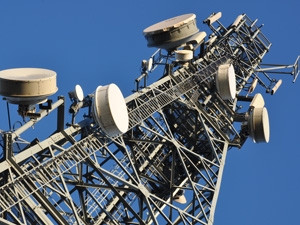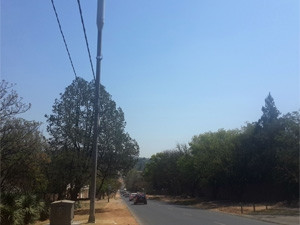
SA's operators are nearing the end of the runway in terms of addressing rising demand and spectrum constraints, and must take action to sustain network performance and retain customers, say industry observers.
According to the Independent Communications Authority of SA, and scores of consumer complaints, SA's mobile network quality has degenerated considerably this year, despite new technologies and creative solutions that are emerging to address this issue, amid sky-rocketing data demands.
MTN CTO Eben Albertyn says consumer complaints in their thousands have informed SA's mobile operators of where - and to what extent - mobile networks are lacking. While solutions are being looked into, challenges like infrastructure issues, lengthy permit processes and limited spectrum have to a degree scuppered initiatives, he adds.
However, analysts note there are a number of solutions available - with more coming to market - to assuage residents' concerns around clunky infrastructure and address their connectivity needs.
Streetlight saga
Certain residents have opposed MTN's street light initiative, whereby the operator is replacing existing lampposts throughout Johannesburg - beginning in Bryanston about three weeks ago - with base stations resembling a streetlight, but bigger and with an electronic box at the bottom.
An opinion piece published on Wednesday via Business Day Live highlighted concerns over a lack of public consultation, and the "unsightly and potentially dangerous" nature of the structures that were "inflicted on [residents] literally overnight".
Albertyn says the company is "engaging constructively with residents and stakeholders" for a resolution.
He says MTN is faced with a mound of consumer complaints, on a regular basis, and points out that people need to make the connection between infrastructure and quality of service.
"Everyone wants to make calls that don't drop and be connected at decent speeds, yet many oppose the notion of more base stations. But the law of physics cannot be changed. The only way we can solve network issues is to bring the signal closer to people." Albertyn adds that the closer a cellphone or device user is to a base station, the lower the signal strength that is transmitted.
Elegant solutions
World Wide Worx MD Arthur Goldstuck says while he is not surprised about residents' objections, people do need to wake up to the fact that, if they want decent quality, there has to be some compromise.
He notes there are solutions that are equally efficient - and more elegant - for example, the Radio Dot System introduced by Ericsson last year. Ericsson says the solution removes indoor bottlenecks, providing coverage to different kinds of users in medium to large indoor locations, via an antenna element, or radio dot.
The surreptitious solution, says Goldstuck, is being used by Vodafone in Europe, although he is unaware of any local applications.

Another solution, introduced by Alcatel-Lucent in 2012, is lightRadio - designed for increasing outdoor coverage. "This is a very elegant solution intended for areas of poor coverage and it is easy to deploy. There are actually a few solutions on the market and these are evolving rapidly and getting better all the time, so I am surprised [MTN] had to create special lampposts."
He says, however, operators are generally not fast at rolling out new technology - partly due to long sales cycles. "While Ericsson and Alcatel-Lucent's solutions are relatively new to the market, given the crisis last year around connectivity in Sandton, I would have thought the operators would start implementing these."
Another, limited, solution is WiFi offload. Goldstuck says this has been a subject of industry talk for years now, but SA is not seeing its implementation. "I think it's a tech take-up issue, rather than a regulatory one. Networks still see WiFi as a competitor rather than a complement."
Albertyn says WiFi offload will only work in very small areas, such as inside a food court. "You cannot, without massive costs, cover a neighbourhood with WiFi. WiFi was made for your living room ? it is not a macro-cellular network. But we are and will be using WiFi offload to increase quality in the very small hotspot locations."
Operator initiatives
Senior BMI-TechKnowledge telecoms consultant Tim Parle says, all things considered, SA's mobile operators cannot be accused of being complacent when it comes to meeting network demand and improving network quality. He says operators are investing billions of rands per year, in planning and configuration tools, drive testing to optimise their networks and understand their competitors' networks, and are now more open to customer feedback regarding blind spots and actively addressing these.
Beyond this, says Parle, the use of camouflaged towers and rooftop facilities in urban areas is a solution. "The use of DAS (Distributed Antenna Systems) in shopping malls, airports and other such structures [is another]. Operators have used techniques such as 'half rate' and other adaptive modulation schemes to adjust voice quality to the network bandwidth available. They are now using very small and discrete base stations in metro areas (about the size of a shoe box) to fill in areas."
Ovum analyst Richard Hurst says, while we only have anecdotal evidence to support the notion of network quality decline ? and any useful data on this subject will be in the hands of the network operators - "we can see that data consumption is on the rise, with more people accessing a variety of services via their mobile devices which will surely place a strain on the networks and their ability to provision services".
Another issue, notes Parle, is that Vodacom, MTN and Cell C had to refarm parts of the spectrum originally used for GSM voice services to make it available for data services (Vodacom and MTN for LTE, Cell C for HSPA+). "Given the rise in subscribers and call volumes, they are having to do more with less (spectrum), which adds to the complexity of the problem."
Goldstuck says, while he has sympathy for operators, they also have to be more transparent about their coverage maps - or else consumer frustration will continue to be directed at them, rather than against residents who are holding back transmissions.
Share